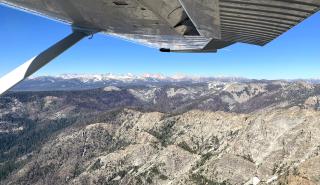
When it comes to getting perspective on forest health, sky-high observations are a big help in California. With over 30 million acres of forested land throughout the state, there is a lot of ground to cover. So, each summer, USDA Forest Service aerial tree survey specialists spend several weeks in the aircraft gathering observations on tree mortality in lands of all ownerships. From above, they read the color of the forest below to determine where trees are recently dead and dying.
The surveys are documenting tree mortality caused by several interconnected factors. First, many areas have too many trees on the landscape, competing for vital resources like water, sunlight, and space to grow. These crowded trees are further stressed and drained of resilience by rising temperatures, drought, disease, and insect infestation. Trees killed by wildfire are not included in these surveys. This is to give focus to the impacts of the other environmental stressors just mentioned. However, the dead, injured and dying trees within forests are prime fuel for burning. So, knowing where large patches of dead and dying trees are located helps land managers identify areas that need to have trees removed to address the wildfire crisis.
Climb inside a Cessna Turbo 182, put on a headset for inflight communication, and take off into a discovery of tree mortality at 1000ft above ground level.
Transcript (PDF, 70 KB)




